This article was first published in the INFOFISH International,
By Yinji Li
In this article, the author, Yinji Li, discusses the vital role of small-scale fisheries in Japan and their unique “Umigyo” approach to sustainability. Li begins by highlighting the historical significance of “small is beautiful” in agriculture and how a similar ethos is emerging in the realm of small-scale fisheries. Whilst these small-scale fisheries are facing a number of challenges due to recent policy changes, Yinji argues that the concept of “Umigyo” offers a strategy for Japan to fulfill its responsibilities as a leader in marine and fisheries industries, aligned with the Sustainable Development Goals (SDGs).
Although it has received a lot of attention in recent years, the topic of fisheries sustainability isn’t new. Despite years of research, it is still difficult to achieve sustainability in many fisheries, and the road to discussions seems never-ending. In this case, there is a growing interest in small-scale fisheries and how they can be crucial to the development of sustainable fishery systems. For the future of our planet, we need to undeniably change our food production systems. One of the most intriguing and possibly the best replicable models could lie in Japan’s small-scale fisheries and their unique “Umigyo” way to protect life below the water by protecting life above water.
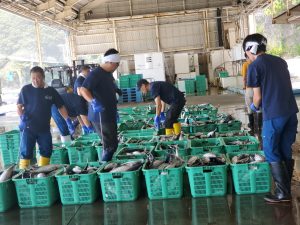
About 50 years ago, the phrase “small is beautiful” was very much in vogue. What it emphasised was the importance of a human-centred economy rather than the expansion of industrial society (Schumacher 1973). In agricultural studies of the past decades, small-scale farming has been attracting attention as a countermeasure against large-scale industrialisation. Similar to this, there is a growing interest in small-scale fisheries in the fishing industry because they have the potential to sustain local communities and use natural resources sustainably.
As represented by the Too Big To Ignore Global Partnership Project (TBTI) small-scale fisheries are generally centred around family businesses that have a strong position in local communities and use fishing practices that are practically unchanged throughout centuries. This is not romanticising ‘small’; It merely emphasises the ability of local people and communities, who traditionally have lived with natural resources such as fish and the sea, and who have the deepest relationship with those resources, in protecting life below the water.
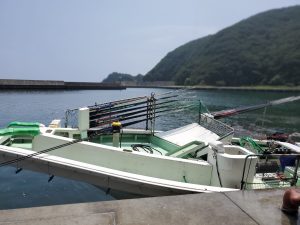
Recognised by the world, the Japanese fisheries governance system has long valued ‘small’. Since the Edo Period (or, Tokugawa period), there has been a rule to use resource called “Iso Wa Jitsuki, Oki Wa Iriai” (the coast is used and managed by local communities, and the offshore is open access) and the coast is owned, used, and managed by its local residents and communities (Li and Namikawa 2020).
These customary fishing rules have been passed down from the 17th century to the present day, protecting the resources and fish-eating culture of the Japanese coast. This type of system is called ‘Japanese-style management’ and has been attracting attention from around the world. However, three years ago, the revision of the Fisheries Act with the keyword of “growth industry” enabled private capital to enter the coastal fishing industry. As a result, there is concern, and rightly so, that something “beautiful” will be lost. The time has come to seriously rethink the meaning of small-scale fisheries.
Japanese small-scale fisheries play an important role in ensuring socially, economically, and environmentally sustainable fisheries. However, they face various challenges, such as the unpredictable household income from fishing, an aging population, the shortage of people to lead the industry, the lack of successors, and the loss of regional vitality.
In order to protect their livelihood without giving up even in these difficult circumstances, various efforts to revitalise fishing villages are being developed around Japan’s coastline. That means fisheries are not just a profit-generating system, but a way of life and gives purpose in the life of small-scale fishers. In addition to reaffirming the important role of small-scale fisheries, it is important to improve the income of fishers and secure fishery workers by supporting the revitalization activities in which small-scale fishers are the main players in various ways. In other words: it is essential to enable viable fisheries.
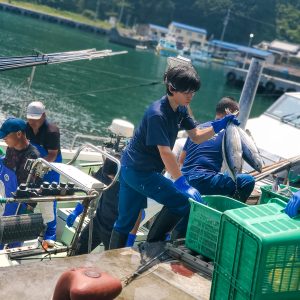 As large-scale and commercial fisheries spread around the world, small-scale fisheries centred on family businesses have been under pressure. Therefore in 2017, the 72nd General Assembly of the United Nations (United Nations) proclaimed 2022 as the International Year of Artisanal Fisheries and Aquaculture (IYAFA 2022), with the FAO serving as the lead agency, in collaboration with other relevant organisations and bodies of the UN system. IYAFA 2022 provided an opportunity to recognize the importance of artisanal fisheries and aquaculture in contributing to sustainable development and to promote the improvement of the challenges faced by these fisheries. Other initiatives like the UN Food Systems Summit in 2021 also highlighted the role that artisanal fisheries can play in ensuring access to safe and nutritious food for all, shifting to sustainable consumption patterns, boosting nature-positive production, advancing equitable livelihoods and building resilience to vulnerabilities, shocks and stress.
As large-scale and commercial fisheries spread around the world, small-scale fisheries centred on family businesses have been under pressure. Therefore in 2017, the 72nd General Assembly of the United Nations (United Nations) proclaimed 2022 as the International Year of Artisanal Fisheries and Aquaculture (IYAFA 2022), with the FAO serving as the lead agency, in collaboration with other relevant organisations and bodies of the UN system. IYAFA 2022 provided an opportunity to recognize the importance of artisanal fisheries and aquaculture in contributing to sustainable development and to promote the improvement of the challenges faced by these fisheries. Other initiatives like the UN Food Systems Summit in 2021 also highlighted the role that artisanal fisheries can play in ensuring access to safe and nutritious food for all, shifting to sustainable consumption patterns, boosting nature-positive production, advancing equitable livelihoods and building resilience to vulnerabilities, shocks and stress.
Small-scale fisheries account for about 50% of the world’s wild caught seafood but employ more than 90% of the people working in the seafood industry. In Japan, 80% of fishers are engaged in coastal fisheries, and 90% of fishing entities are family operations, but the number of fishers has decreased significantly over the last years.
“The future of fishing is in artisanal and without large fleets,” stated world-renowned scientist, Daniel Poly. Sven Jentoft, also a prominent sociologist of fisheries, said in his book ‘Life Above Water (2019)’, that it is essential to protect small-scale fisheries and fishing villages.
All of them strongly express the role and significance of small-scale fisheries, which have the ability to be fully sustainable and are capable of preserving ecosystems, because they value their resources. More important to remember; preserving the pride and happiness of the people involved in small-scale fisheries, while passing on their history and traditional culture and sustaining local communities can not always be expressed in a spreadsheet or on graphs, and their significance is truly great.
However, the stakes have never been higher for small-scale fisheries. Small-scale fisheries, which are often ignored due to their small(er) scale, have always faced many challenges, including poverty, food insecurity, lack of access to resources, gender inequality, and unequal allocation from resources.
In recent years, economic initiatives such as “Blue Economy” and “Blue Growth”, have taken the lead in industry and small-scale fisheries have been exposed to the threat of annihilation. One example is the Japanese Fisheries Act that underwent a major revision, with the key word being “growth industry.” New policies, such as allowing private capital to enter coastal fisheries, have given rise to a range of concerns about the sustainability of small-scale fisheries under new legislation that emphasises economic efficiency.
Because small-scale fisheries have been consistently marginalised and persecuted relative to their importance, the concept of “Blue Justice” has been advocated as a counter-concept and we see this concept rapidly spreading (Li 2022). That the U.N. dedicated the complete year 2022 (IYAFA) is reflective of the fact that small-scale fisheries, which play an important role in maintaining sustainable fisheries, are in such a critical situation.

Researchers, who have pointed out the current situation of small-scale fisheries at various conferences and policy forums, launched a project called the TBTI (Too Big To Ignore) Global Partnership in 2012. And in Japan, the TBTI Japan Research Network was launched in 2020.
This network not only focuses on research, but it also brings together researchers, government officials, practitioners, fishery officials, and community groups to participate in creating standpoints, based on local knowledge and facts. Every four years, TBTI organises a large multidisciplinary forum called the World Small Scale Fisheries Congress (WSFC). This is a conference where anyone who works with or is interested in small-scale fisheries can participate.
The overarching goal of this conference is to bring everyone together to share information on all aspects of small-scale fisheries and develop action plans and capacity-building programs to support the implementation of FAO’s Small-Scale Fisheries Guidelines. For example, the 4th World Small-Scale Fisheries Congress Asia Pacific was held in Shizuoka in 2022 and brought together 250 delegates from over 30 countries with its main theme “Building Forward Better.”
Because we are in a period of significant changes in policies regarding marine resources and environmental protection, Japan must reaffirm the importance of small-scale fisheries and fully implement the FAO’s small-scale fisheries guidelines.
Small-scale fisheries are not only ‘too big to ignore’, their policy failures are irreversibly costly to the environment, natural resources, and providing food security to the world. When you put seafood on your table, please think about the small-scale fishers around the world making strenuous efforts to provide it to you.
The term “Umigyo” refers to a variety of values as well as resources for the revitalization of regions and fisheries, including the culture associated with fishing and the landscape of fishing villages. Recently, this maritime term has been frequently heard from governments and the private sectors. However, there is a concern that it will be perceived as nothing more than a “marine business” in comparison to the initial “economic activities led by fishers and community people.”
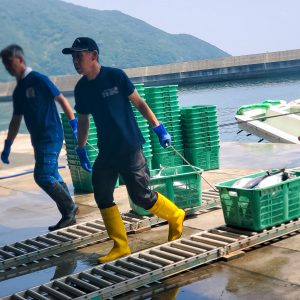 There are various examples of Umigyo, including direct seafood sales, marine leisure and tourism, maritime culture, and hands-on learning. These not only provide new opportunities and livelihoods for those involved in the fishing industry, but also provide a social contribution and social responsibility of small-scale fisheries and coastal communities to contribute to the prosperity of the entire nation.
There are various examples of Umigyo, including direct seafood sales, marine leisure and tourism, maritime culture, and hands-on learning. These not only provide new opportunities and livelihoods for those involved in the fishing industry, but also provide a social contribution and social responsibility of small-scale fisheries and coastal communities to contribute to the prosperity of the entire nation.
Based on this, the Umigyo is defined as “a series of economic activities carried out by community people, centered on fishers and fishers’ organisations, for answering diverse needs on marine and coastal use today, utilising not only fishery resources but also various local resources such as the sea, landscapes, traditions, and cultures (Lou 2013).”
On the other hand, the idea proposed by the Japanese Fisheries Agency in 2022 is that it is “a business that utilises the value and charm of local resources such as the sea and fishing villages, and by responding to various domestic and overseas needs It is expected to generate income and employment.”
The definition of who uses what and who does what needs to be clarified. The Fisheries Agency’s proposal, however, is ambiguous regarding the “who”, which clearly differs from the earlier. If only economic development proceeds while the actor is ambiguous, there is a concern that the entry of private capital will result in development without fishers.
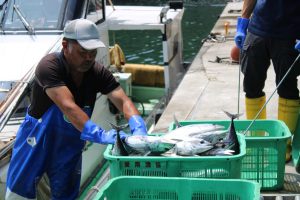 Japan’s small-scale fisheries clearly have an important role to play and provide a good example of how sustainability can be achieved in fisheries. However, to this day, small-scale fisheries still face various challenges, such as the aging population, lack of successors and workers, instability of fishing household income, and declining regional vitality.
Japan’s small-scale fisheries clearly have an important role to play and provide a good example of how sustainability can be achieved in fisheries. However, to this day, small-scale fisheries still face various challenges, such as the aging population, lack of successors and workers, instability of fishing household income, and declining regional vitality.
In addition to these issues, there have been recent calls for a Blue Economy and Blue Growth, and policies such as “turning fishing communities into theme parks” have been launched both in Japan and overseas to encourage private capital to enter coastal fisheries and fishing communities with fishers left behind.
Umigyo is an effective and indispensable means of responding to these longstanding unresolved issues as well as new issues that are emerging. What makes this possible is the deep philosophy and science that “the Umigyo is not just a business related to the sea.”
In order to protect the life below water (marine resources), it is essential to protect the people, communities, and societies (life above water) that are closely related to them.
The Umigyo is a way to protect life below the water by protecting life above water, and it can be said that it is a strategy that enables Japan to fulfil its responsibilities as an advanced country in the marine and fisheries industries by realising the SDGs.
Future development of diverse Umigyo in many fishing communities will require the protection of independent rights like fishers’ management of sea and coastal resources and local resource management, as well as the participation of various locals and fields both inside and outside the region. It is necessary to encourage cooperation with the fishing communities and investigate the Umigyo’s proper approach, which takes into account the unique circumstances of the communities and areas where fishing is practised.
Smaller fishing communities with declining vitality need more Umigyo engagement. However, these areas are less familiar with the Umigyo and do not have the ability to collect information, so there is a possibility that they will be left behind in the development process.
In order to avoid ironic consequences such as leaving regions/communities that need the Umigyo behind, we must also consider how government support and research promotion should be. As a researcher of small-scale fisheries and fishing communities, I myself have great expectations for the new era of the Umigyo, but I am keenly aware of my responsibility at the same time.
I hope that consumers will also pay close attention to the development of the Umigyo as a topic that affects all citizens, and actively communicate what they want in terms of fisheries, marine resources, and the way of existence of fishing communities.
 Yinji Li is an Associate Professor at Tokai University, Japan. With language skills in Japanese, Korean, Mandarin, and English, her research interests and expertise lie in small-scale fisheries in Northeast Asian regions. Dr. Li leads the TBTI (Too Big To Ignore) Japan Research Network. Her recent books ‘In the Era of Big Change’, and ‘Suimen Jono Seimei (Life Above Water translation)’ emphasising the importance of small-scale fisheries, co-edited with Tamano Namikawa, were published by TBTI Global in 2020 and 2022. Dr. Li is also the Japan country team coordinator of the Vulnerability to Viability Global Partnership (V2V) project, and a member of the Board of Trustees at the International Pole and Line Foundation (IPNLF).
Yinji Li is an Associate Professor at Tokai University, Japan. With language skills in Japanese, Korean, Mandarin, and English, her research interests and expertise lie in small-scale fisheries in Northeast Asian regions. Dr. Li leads the TBTI (Too Big To Ignore) Japan Research Network. Her recent books ‘In the Era of Big Change’, and ‘Suimen Jono Seimei (Life Above Water translation)’ emphasising the importance of small-scale fisheries, co-edited with Tamano Namikawa, were published by TBTI Global in 2020 and 2022. Dr. Li is also the Japan country team coordinator of the Vulnerability to Viability Global Partnership (V2V) project, and a member of the Board of Trustees at the International Pole and Line Foundation (IPNLF).
Schumacher, E.F. (1973) Small Is Beautiful.
Lou X (2013) The era of Umigyo: challenges towards the activation of fishing communities. Rural
Culture Association Japan, Tokyo [In Japanese]
Jentoft, S (2019) Life Above Water. TBTI Global Publication Series, St. John’s.
Li Y, Namikawa T (2020) In the era of big change: essays about Japanese small-scale fisheries. TBTI Global Publication Series, St. John’s.
Li, Y. (2022). Adopting a Blue Justice Lens for Japanese Small-Scale Fisheries: Important Insights from the Case of the Inatori Kinme Fishery. In: Jentoft, S., Chuenpagdee, R., Bugeja Said, A., Isaacs, M. (eds) Blue Justice. MARE Publication Series, vol 26. Springer, Cham. https://doi.org/10.1007/978-3-030-89624-9_15
Note: This article is an adaptation of the articles published in Tabemono Tsushin (food news) (No.616, No.621, No.626).